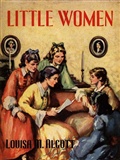
Little Women Louisa May Alcott Book
by Louisa May Alcott
Book Comments & Discussion

Thi is such a cute and beautiful classic novel. I have it on kindle.
Post Comment - Let others know what you think about this book
Storyline
This unique version also includes the following bonus annotations:- Biography of the author
- Historical context of the book
- Literary critique
Little Women (or Meg, Jo, Beth and Amy) is a novel by American author Louisa May Alcott (1832–1888). Written and set in the Alcott family home, Orchard House, in Concord, Massachusetts. It was published in two parts in 1868 and 1869. The novel follows the lives of four sisters—Meg, Jo, Beth, and Amy March—and is loosely based on the author's childhood experiences with her three sisters. The first part of the book was an immediate commercial and critical success, prompting the composition of the book's second part titled Good Wives, also a huge success. Both parts were first published as a single volume in 1880. Alcott followed Little Women with two sequels reprising the March sisters, Little Men (1871) and Jo's Boys (1886). Little Women has been adapted to play, musical, opera, film, and animated feature.
Alcott's original work explores the overcoming of character flaws. Many of the chapter titles in this first part are allusions to the allegorical concepts and places in Pilgrim's Progress. When young, the girls played Pilgrim's Progress by taking an imaginary journey through their home. As young women, they agree to continue the figurative journey, using the "guidebooks" — copies of the New Testament, described as "that beautiful old story of the best life ever lived" (chapter 1, see also chapter 19) — they receive on Christmas morning. Each of the March girls must struggle to overcome a major character flaw: Meg, vanity; Jo, a hot temper; Beth, shyness; and Amy, selfishness. The girls must work out these flaws in order to live up to their mother and father's high expectations as mothers, wives, sisters, and citizens.
In the course of the novel, the girls become friends with their next-door neighbor, the teenage boy Laurie (whose given name is "Theodore"), who becomes a particular friend of Jo. In addition to the more serious themes outlined above, the book describes the light hearted, often humorous activities of the sisters and their friend, such as creating a newspaper and picnicking, and the various scrapes that Jo and Laurie get into. The story represents family relationships and explores family life thoroughly. It also reflects issues of feminism, as Jo consistently struggles with the boundaries 19th century society placed on females, including not being able to fight in a war, not being able to attend college, and being pressured by her Aunt March to find a suitable husband to take care of her.
Report Abuse for this page, if inappropiate
Books on the site are added by members. You can add a book too. Click here to add one.
Stats for this Book
Oct 2011
1,211 Views
Last Viewed: May 9
Last Liked: May 2023
 Love is the title of everything beautiful: More love for more happy life
Love is the title of everything beautiful: More love for more happy life The Blast Furnace: Ian Macdonald
The Blast Furnace: Ian Macdonald Hunger Games: Suzanne Collins
Hunger Games: Suzanne Collins The Secret: Rhonda Byrne
The Secret: Rhonda Byrne The Alchemist: Paulo Coelho
The Alchemist: Paulo Coelho